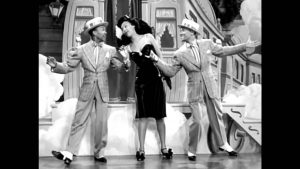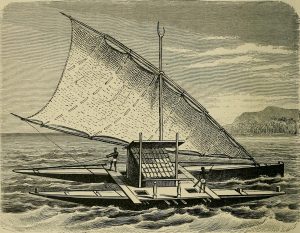Imagine running across a field. You’re tired and out of breath. You’ve been in what seems like an endless game. From sun up to sundown you’re running and fighting to make a goal. To some, it may seem like a game, but not to you. To you, it’s part of your culture, your religion, and, to you, the outcome matters.
Lacrosse was first played by Native American tribes in different regions of North America. There were many different versions of the game, rules, numbers of players, and sizes of the fields that would change depending on the tribe. Names of the game also varied, and included Creators’ Game, Baggataway, and Tewaaraton, which translates to “little brother of war.”1

The name that we know today as lacrosse came about in 1636 when French Missionary Jean de Brebeuf compared the shape of the sticks used by players of the game to a bishop’s crozier, which is ‘‘crosse’’ in French.2
For many Native American tribes, lacrosse wasn’t just a sport, but rather part of their culture and their religion. Since the game was very rough and people could be injured and even die while playing, the Iroquois used lacrosse as a way of training young men to be warriors, and the game was used to settle disputes without actually going to war. This is why lacrosse is nicknamed “little brother of war.”3 Lacrosse also had religious significance among some tribes. It was called the Creator’s Game, and it helped the players put their lives into perspective and teach lessons, some of the most valuable lessons being that everyone has struggles and opponents and the key to survival is friends and allies.
In the culture of the Iroquois, when a man dies, his lacrosse stick is buried with him. They believed that the first thing he would do when he wakes up in the afterlife is to take the stick from his coffin and begin playing that day.4

Native American lacrosse was often played on a stretch of land up to two miles long with sticks between 3-5 feet long made of wood and animal skin. A game could include between one-hundred to one-thousand players at a time. There was no set time to the games. The two teams would agree on a set amount of points and would play from sunrise to sunset until the amount of points was achieved.5 Violence and injuries were very common, and players would often walk away with minor cuts, broken bones, head injuries, and occasionally a death would occur.
Few people can claim to have experienced a Native American game of Lacrosse. Artist George Catlin had a passion for learning about Native Americans, and how they lived. He once said that “If my life is spared, nothing shall stop me short of visiting every nation of Indians on the Continent of North America.” He attended a major Choctaw lacrosse game in 1834. In his time there, he recorded everything that he saw and described how the game was set up from the length of the field and deciding where the goals would be places, to how each team was set up. He described how the night before the match both teams danced and chanted all night. Each team had a medicine man who chanted incantations to strengthen their team and weaken the other. He recorded his experiences through paintings and writings.6
Lacrosse is a sport that has a beautiful history and carries a meaning that many of us will never be able to understand. To Native Americans, lacrosse was a sport, a teaching tool, a religion, and a way to connect their cultures with other tribes.7 Today the history and meaning behind lacrosse has been lost, and to many it has become just another sport played for recreation and friendly competition.
- The Gale Encyclopedia of Fitness, 2012, s.v. ‘”Lacrosse,” by David E. Newton. ↵
- Salem Press Encyclopedia, 2017, s.v., “Lacrosse,” by Justin D. Garcia. ↵
- Thomas Vennum Jr., “American Indian Lacrosse: Little Brother of War,” The Journal of American Folklore 108, No. 427 (1995): 98-99. ↵
- S. L. Price, “Pride of a Nation,” Sports Illustrated 113, no. 2 (2010): 60-71. ↵
- Stanley A. Freed, “Lacrosse yesterday and today,” Cobblestone 15, no.9 (1994): 32. ↵
- Joanna Shaw-Eagle, “Catlin saves vanishing Indians on canvas,” The Washington Times, January 4, 2003. ↵
- John Seabrook, “Gathering of the Tribes,” New Yorker 74, No. 26, (August 1998): 30. ↵



154 comments
Daniela Iniguez-Jaco
This was an amazing article, amazing job writing it! Before reading this article I had no idea about how Lacrosse came to be. I would have never guessed it came from Native Americans! Not to mention that it is not just a game for them, it is part of their culture. After reading that some have died during lacrosse it got me thinking about how they bury them with their sticks. I will now be telling everyone I know about the history of Lacrosse
Louis Martinez
It is very interesting to me how this sport meant so much significance to the Native Americans and it’s nice to know there was a very deep meaning behind the playing of this sport than just for fun. Nowadays when we play a sport I feel like collectively we mostly do it just to have fun or because we like it but it’s cool to see how the same sports we play were started back then and why they were started and what they even may mean to others because it’s evident that to some it definitely was not just for fun but had much meaning such as cultural how they used the dangerous risky sport to train young men to be warriors and also how they even played the sport to settle conflicts rather than going to war! Oh, what a different place the world be if we all did that. It’s also interesting how this sport had significant religious meaning too. Even the tools used to play these sports were very symbolic such as the burying of a man with his lacrosse stick when he dies. The preparation of this game kind of reminds me of the super bowl there is a lot of hype and excitement built around this game for the Native Americans and even things like the superstitions we do today such as the “medicine man” who chants incantations to strengthen the team and weaken the opponents.
Trenton Boudreaux
I never realized that Lacrosse originated in Pre-Contact North America nor that it held such importance. The introduction really helped draw me into what a game of lacrosse would have been like to the Native American’s who played it. The choice of images also helped me to visualize what the game would have looked like at the time as well as further drawing me in.
Daniela Iniguez-Jaco
This was an amazing article, amazing job writing it! Before reading this article I had no idea about how Lacrosse came to be. I would have never guessed it came from Native Americans! Not to mention that it is not just a game for them, it is part of their culture. After reading that some have died during lacrosse it got me thinking about how they bury them with their sticks.
Ariette Aragon
The introduction really caught my attention and motivated to read the article, it really drew me in. I didn’t know that Lacrosse was first played by the Native Americans and found very intriguing the purpose of it. I think it is important to remember the roots and origin of things, specially something as meaningful as this sport so thank you for writing this amazing article. Also, I would like to mention the pictures you used, which really allowed me to have a clear idea of what I was reading and feel like a was there in that time and place.
Matthew Tobar
First and foremost, this was a fantastic article. Thank you for writing it! I like how you draw readers in with a descriptive setting of the game, getting us in the right mindset to read this article. This was quite a compelling narrative that really drew me in. Even though this was required, I still enjoyed reading it, it’s informative, succinct, full of interesting facts and information, and it tells a story. I specifically like the detail about how the Iroquois men are buried with their lacrosse sticks, it really shows how ingrained with the culture this is. And through this article, you are honoring the legacy of those who participated in this sacred ritual. You have a really strong writing style, and it shows. You should do this professionally! Thanks again for writing such a great article!
Jourdan Carrera
The Author did a great job in the use of the very vivid images such as that of the ‘Ball Players’ and that of the ‘Play of the Choctaw Ball Up’. There was also a very real sense of passion that emanated from the author’s writing which is evident in the detail put into the historical piece; an example of this being the inclusion of the the description of the game by George Catlin from 1834.
Kensley Dieckow
I think the author did an amazing job explaining all the ways that Lacrosse was more than a sport to the Native Americans. The way that the Native Americans use the game as a part of their culture to settle disputes with other tribes and to train warriors and as a part of their religion to teach life lessons shows to the extent in which the Native Americans were able to give a deeper meaning to the game. Great job in bringing out the deeper meaning in the game.
Samuel Vega
I never knew Native American’s created a game such as lacrosse. I was first introduced to Lacrosse in high school. I found it fascinating how the material used for the sticks were made and how the game was used in mediation. The article makes you think more of the origins of other customs and the purposes that they served. This was a great article and it had a lot of great information I did not know about Native Americans.
Claudia Sanchez
This article was an interesting outlook into how sports took on a very spiritual and cultural meaning to Native Americans. I appreciate the creativity of the author to consider such a topic. Likewise, the images chosen by the author provide an excellent historical representation of the players and the event at large. The opening paragraph was an enticing and exciting entrance that set the stage for the importance of lacrosse that was discussed in the article. Very informational and well written.